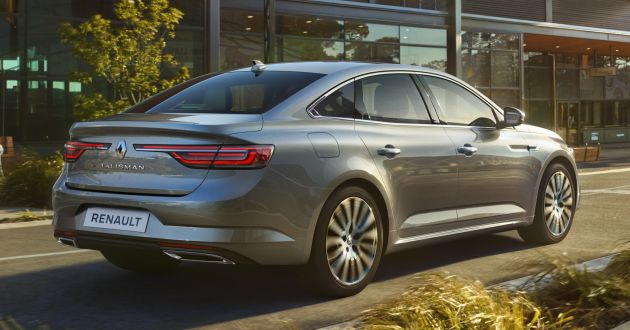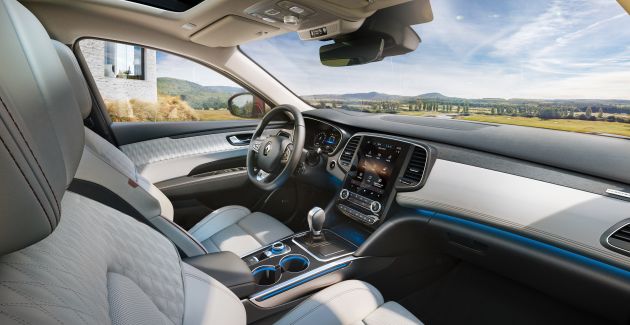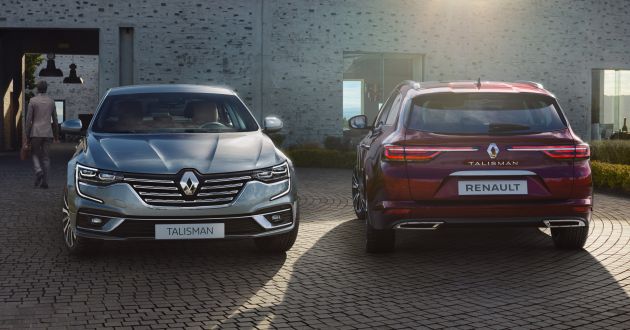First introduced in 2015, the Renault Talisman has now been given a facelift that also sees improvements to the list of available equipment ahead of a market launch in June this year. At first glance, you’d be hard pressed to spot the visual changes that have been made, but they are there, albeit very subtle.
At the front, the bumper has been reprofiled and is joined by a new grille with transverse chrome slats. The entire Talisman range also comes with full-LED headlamps and the company’s signature C-shaped LED DRLs, with the option of adaptive matrix LED technology and dynamic indicators. Renault says the new tech improves the visibility range of 220 m from 175 m previously.
New colours options have also been added, including Baltic Grey, Vintage Red, and Highland Grey, while a selection of alloy wheels Pierre (17-inch), Stellar (18-inch), and Sato (19-inch) also join the list of offerings.
At the rear, the wide-width LED taillights gain a new light signature and the fancy indicators as well as chrome fittings to accentuate their new design. Renault also added a shark fin antenna to the roof, which it says is necessary to improve the quality of the multimedia system inside.
On that mention, the cabin’s centre console gets chrome trim pieces on either side, along with mood lighting – eight presets are available – to highlight its shape. On higher-spec Initale Paris variants, a new ceruse wood finish is applied on the dashboard and doors.
A more substantial revision is the fitment of a 10.2-inch fully-digital instrument cluster display on Intens variants onwards. This is tied to the car’s Multi-Sense system that enables full customisation with GPS navigation display.
The Multi-Sense system can be accessed via the Easy Link infotainment system, which is part of the Easy Connect ecosystem that also includes My Renault app telemetry and other connected services. Depending on the chosen grade, there’s either a 9.3- or 7-inch touchscreen, both with support for Android Auto or Apple CarPlay.
Other improvements involve ergonomics and practicality, with a frameless, electrochromic rear-view mirror, and larger cup holders that now come with chrome trimmings and back lighting. There’s also a wireless phone charger, while the climate dials now feature a digital display for adjusting the temperature.
You also get an Auto Hold button that keeps the vehicle stationary when the parking brake is not applied, and Renault finally saw it fit to relocate the cruise control buttons from the centre console to the steering wheel, describing it as providing a “more user-friendly experience.”
New advanced driver assistance systems are also part of the update, including Highway & Traffic Jam Companion that combines adaptive speed control with Lane Centering Assistance. The function works at speeds of up 160 km/h, and can cope with going around curves and will automatically stop and start the car within three seconds without the driver having to do a single thing.
The improved Active Emergency Braking System (AEBS) is now able to detect pedestrians and cyclists, and is joined by existing systems like Lane Departure Warning, Lane Keeping Assist, driver drowsiness detection, Blind Spot Warning (now uses two radar sensors) and Rear Cross Traffic Alert.
Depending on the market, the refreshed D-segment model – available in sedan and estate body styles – will be available with a number of powertrains but no hybrid options (for now). The range includes a 1.3 litre turbocharged four-cylinder petrol engine with 160 hp and 270 Nm, which is coupled to a seven-speed dual-clutch EDC transmission (TCe 160 EDC FAP). This setup has a fuel consumption of 6.2 l/100 km and emits 140 g/km of CO2 following the WLTP cycle.
There’s also the TCe 225 EDC FAP with a larger 1.8 litre turbo-four petrol unit that serves up 225 hp and 300 Nm, also with the seven-speed EDC. It consumes more fuel at 7.4 l/100 km and has higher CO2 emissions at 166 g/km. The “FAP” in the powertrain names refers to the presence of a particle filter.
On the diesel side of things, the line-up starts with a 1.7 litre four-cylinder Blue dCi engine that provides either 120 hp or 150 hp, paired with a six-speed manual and has a fuel consumption rating as low as 4.9 l/100 km. Higher up the range is a 2.0 litre unit with either 160 hp or 200 hp, both with a six-speed EDC gearbox – the 200 hp version is rated at 5.6 l/100 km and 146 g/km. Cars equipped with the 4Control four-wheel steering system also now benefit from adjustable damping.










Tinggalkan komen anda